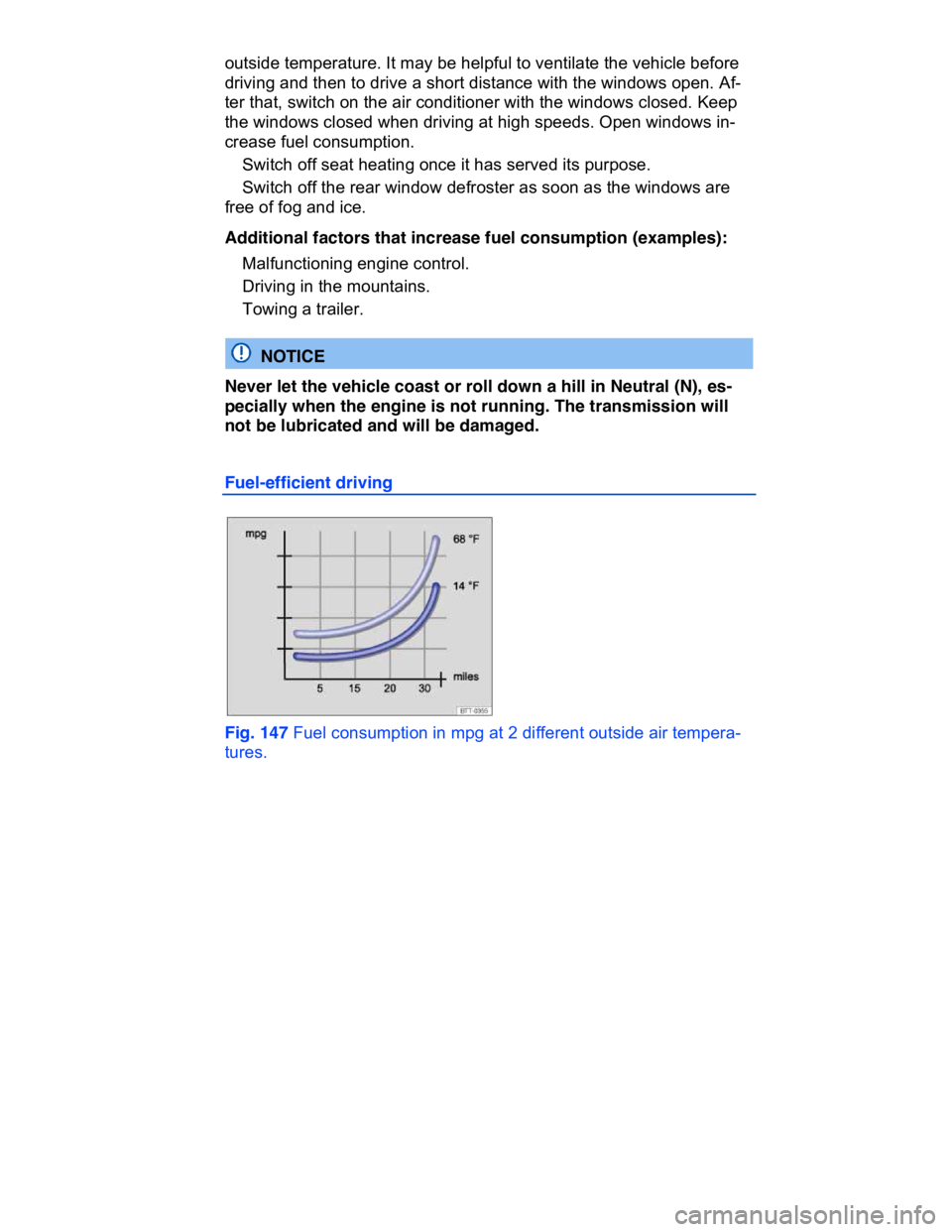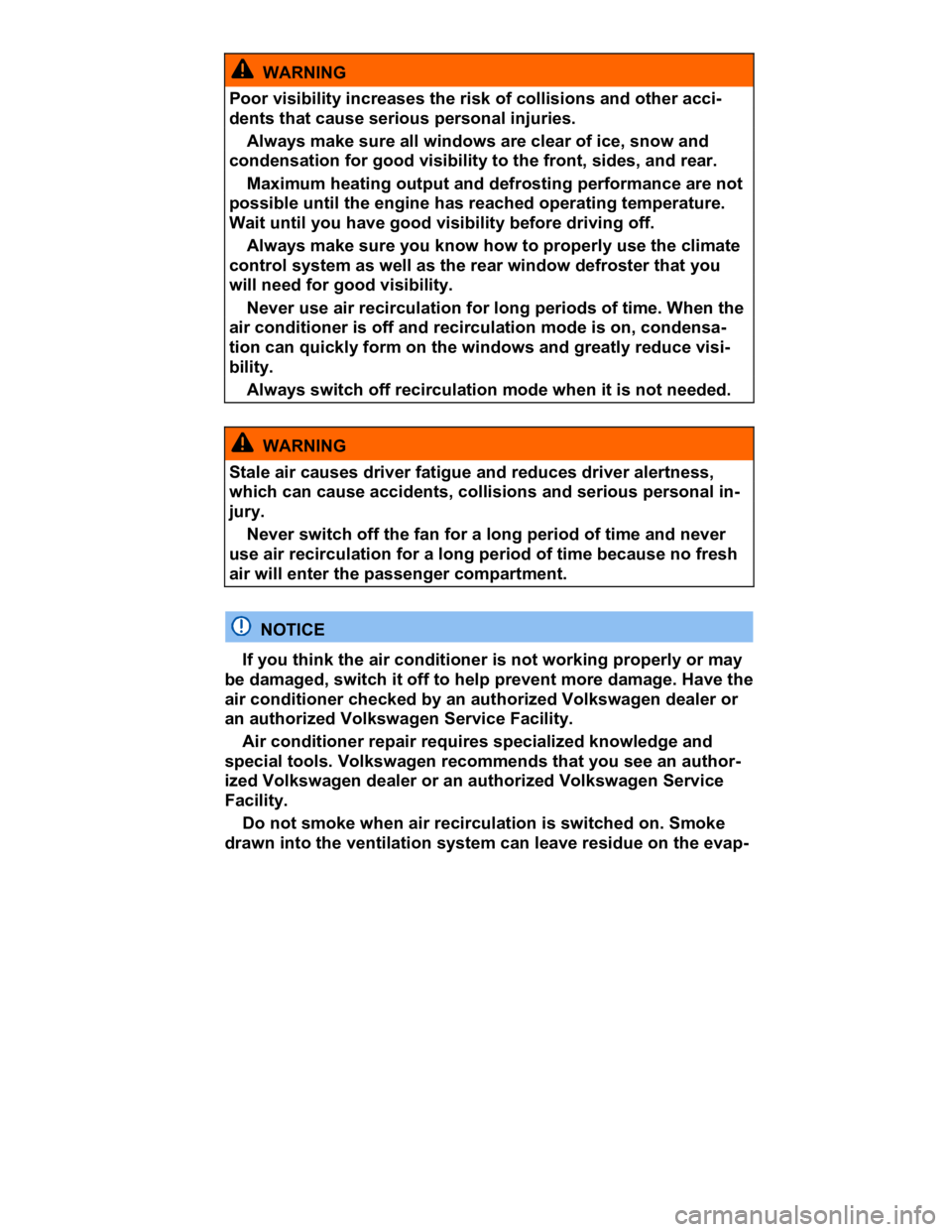engine VOLKSWAGEN CC 2014 Repair Manual
[x] Cancel search | Manufacturer: VOLKSWAGEN, Model Year: 2014, Model line: CC, Model: VOLKSWAGEN CC 2014Pages: 578, PDF Size: 6.64 MB
Page 352 of 578

Check the information on the container for the brake fluid you want to
use to make sure it meets the requirements for your vehicle.
Brake fluid that complies with VW Standard 501 14 can be pur-
chased from your authorized Volkswagen dealer or authorized
Volkswagen Service Facility.
If this special brake fluid is not available you may – under these cir-
cumstances – use another high quality brake fluid that complies with
U.S. Federal Motor Vehicle Safety Standard (FMVSS) 116 DOT 4 ⇒
.
Please note, however, that not all brake fluids that comply with U.S.
Federal Motor Vehicle Safety Standard FMVSS 116 DOT 4 have the
same chemical composition. Some of these brake fluids can contain
chemicals that could, over time, degrade or damage internal parts of
the vehicle’s brake system.
Volkswagen therefore recommends that you use brake fluid that ex-
pressly complies with VW Standard 501 14 for optimum brake sys-
tem performance over the long term.
Brake fluid level
The fluid level in the transparent brake fluid reservoir must always be
between the MIN and MAX marking ⇒ .
On some vehicles, engine components block the view of the brake
fluid reservoir and make it impossible to see the brake fluid level. If
you cannot clearly see the brake fluid level in the brake fluid reservoir,
please see an authorized Volkswagen dealer or authorized
Volkswagen Service Facility.
The brake fluid level drops slightly when the vehicle is being used as
the brake pads wear and the brakes are automatically adjusted.
Changing brake fluid
Brake fluid must be changed according to the service schedule in
your ⇒ Booklet Warranty and Maintenance. Have the brake fluid
checked by an authorized Volkswagen dealer or an authorized
Volkswagen Service Facility. Refill only with new brake fluid that
meets the standards listed above.
Page 356 of 578

Vehicles with gear recommendation aid in fuel efficient driving by in-
dicating the optimum time to shift gears.
Coasting
If you take your foot off the accelerator, fuel delivery to the engine is
interrupted, which lowers fuel consumption.
Therefore, when nearing a red stop light, for instance, allow the vehi-
cle to coast without using the accelerator. Press the clutch pedal and
release it only if the vehicle moving too slowly or the coasting dis-
tance is too long. The engine will then continue to run at idle.
In situations where the vehicle will be stopped for a longer period of
time, such as at a railroad crossing, physically switch off the engine.
Defensive driving and “flowing” with traffic
Frequent braking and acceleration increase fuel consumption signifi-
cantly. Just by driving defensively and keeping a sufficiently large
distance away from the vehicle in front of you can make up for the
speed fluctuations caused by taking your foot off the accelerator. Ac-
tive braking and accelerating is then not necessarily required.
Calm and smooth driving
Consistency is more important than speed. The more smoothly you
drive, the less fuel the vehicle consumes.
When driving on the highway or freeway, a constant, moderate speed
is more efficient and economical than constantly accelerating and
braking. Usually you can reach your destination just as quickly by
driving at a moderate, but steady speed.
The cruise control system can assist in maintaining a uniform driving
style.
Moderate use of extra electrical loads
Comfort inside the vehicle is nice and important, but it is important to
use them in an environmentally conscious manner.
Some devices can increase fuel consumption when activated (exam-
ples):
� Climate control system (air conditioner): If the air conditioner has to
produce starkly contrasting temperatures, it requires a large amount
of energy, which is generated by the engine. The temperature in the
vehicle should therefore not be extremely different from that of the
Page 357 of 578

outside temperature. It may be helpful to ventilate the vehicle before
driving and then to drive a short distance with the windows open. Af-
ter that, switch on the air conditioner with the windows closed. Keep
the windows closed when driving at high speeds. Open windows in-
crease fuel consumption.
� Switch off seat heating once it has served its purpose.
� Switch off the rear window defroster as soon as the windows are
free of fog and ice.
Additional factors that increase fuel consumption (examples):
� Malfunctioning engine control.
� Driving in the mountains.
� Towing a trailer.
NOTICE
Never let the vehicle coast or roll down a hill in Neutral (N), es-
pecially when the engine is not running. The transmission will
not be lubricated and will be damaged.
Fuel-efficient driving
Fig. 147 Fuel consumption in mpg at 2 different outside air tempera-
tures.
Page 359 of 578

Adjust the tire pressure
The proper tire pressure helps reduce rolling resistance as well as
fuel consumption.
When purchasing new tires, always make sure that the tires are opti-
mized for lower rolling resistance.
Use low viscosity engine oil
Fully “synthetic,” low viscosity engine oils that expressly comply with
Volkswagen oil quality standards reduce fuel consumption. Low vis-
cosity engine oils reduce the frictional resistance on the engine and
are distributed more evenly and quickly, particularly when cold-
starting the engine. The effect is particularly apparent in vehicles that
frequently travel short distances.
Always ensure the right engine oil level is maintained and keep to the
scheduled service intervals (engine oil changes).
Make sure the engine oil that you purchase expressly complies with
Volkswagen oil quality standards and is the oil approved by
Volkswagen for your vehicle.
Avoid unnecessary weight
The lighter the vehicle, the more economical and eco-friendly it will
be. For example, an extra 220 lbs (100 kg) of weight increases fuel
consumption by up to 1 pint per 60 miles (0.3 l/100 km).
Remove all unnecessary items and unnecessary dead weight from
the vehicle.
Remove unnecessary aftermarket components
The more aerodynamic the vehicle, the less fuel it will consume. Af-
termarket components such as bicycle racks reduce its aerodynamic
performance.
Therefore, remove unnecessary structures and unused rack systems,
particularly if planning to drive at higher speeds.
Page 362 of 578

Step Manual transmission Automatic transmission
1. Hold the stopped vehicle on an incline with the foot or parking
brake.
2. The engine must be running “smoothly.”
3. A manual transmission vehicle
must be in 1st gear (1) if
headed up a hill or in Reverse
(R) if backing up a hill; you
must hold the clutch down and
the foot brake must be de-
pressed to keep the vehicle
from moving.
An automatic transmission
vehicle must be in Reverse
(R), Drive (D), or Sport Drive
(S) and the foot brake must be
depressed to keep the vehicle
from moving.
4. To drive off, take your foot off
the brake pedal as you let the
clutch out and gently depress
the accelerator within
2 seconds.
To drive off, take your foot off
the brake pedal and gently
depress the accelerator within
2 seconds.
Hill Hold is immediately deactivated:
� If any requirement listed in the table above is no longer met.
� If the engine is not running smoothly or the engine malfunctions.
� If the engine stalls or is switched off.
� Automatic transmission vehicles: If the transmission is in Neutral
(N).
� Automatic transmission vehicles: If a tire does not have enough
road contact (such as when the vehicle is tipped or at an angle).
Page 368 of 578

In order to: You must ⇒ fig. 151 Result:
Resume speed
stored in cruise
control.
Pull the lever briefly to
the �2�%�3�5�-�% position (1).
Cruise control resumes
speed previously set.
If there is not a previously
stored speed, the cruise
control system stores and
maintains the current
speed.
If the cruise control is al-
ready regulating vehicle
speed, the stored speed
is increased by 1 mph
(1 km/h) each time the
lever is pulled.
Increase set
speed (while
cruise control is
actively control-
ling vehicle
speed).
Push the lever briefly
to the �3�0�%�%�$ + posi-
tion (+) to increase the
set speed in incre-
ments of 5 mph
(10 km/h) and store.
The vehicle will accelerate
until the new higher speed
is reached and saves the
new higher speed in the
memory.
Push and hold the
lever in the �3�0�%�%�$ +
position (+) to in-
crease the set speed
continuously until the
higher desired speed
is reached and the
lever is released.
Reduce set
speed (while
cruise control is
actively control-
ling vehicle
speed).
Push the lever briefly
to the �3�0�%�%�$ – posi-
tion (–) to reduce the
set speed continuous-
ly in increments of
5 mph (10 km/h) and
store.
Cruise control will slow
the vehicle down without
braking by reducing the
flow of fuel to the engine
until the new lower speed
is reached and saves the
new lower speed in the
Page 385 of 578

WARNING
Poor visibility increases the risk of collisions and other acci-
dents that cause serious personal injuries.
� Always make sure all windows are clear of ice, snow and
condensation for good visibility to the front, sides, and rear.
� Maximum heating output and defrosting performance are not
possible until the engine has reached operating temperature.
Wait until you have good visibility before driving off.
� Always make sure you know how to properly use the climate
control system as well as the rear window defroster that you
will need for good visibility.
� Never use air recirculation for long periods of time. When the
air conditioner is off and recirculation mode is on, condensa-
tion can quickly form on the windows and greatly reduce visi-
bility.
� Always switch off recirculation mode when it is not needed.
WARNING
Stale air causes driver fatigue and reduces driver alertness,
which can cause accidents, collisions and serious personal in-
jury.
� Never switch off the fan for a long period of time and never
use air recirculation for a long period of time because no fresh
air will enter the passenger compartment.
NOTICE
� If you think the air conditioner is not working properly or may
be damaged, switch it off to help prevent more damage. Have the
air conditioner checked by an authorized Volkswagen dealer or
an authorized Volkswagen Service Facility.
� Air conditioner repair requires specialized knowledge and
special tools. Volkswagen recommends that you see an author-
ized Volkswagen dealer or an authorized Volkswagen Service
Facility.
� Do not smoke when air recirculation is switched on. Smoke
drawn into the ventilation system can leave residue on the evap-
Page 390 of 578

Air conditioner does not work
The air conditioner may not switch on for one of the following rea-
sons:
� The engine is not running.
� The fan is switched off.
� The air conditioner fuse has blown.
� The outside air temperature is colder than about +38 °F (+3 °C).
� The air conditioner compressor has been temporarily switched off
due to excessive engine coolant temperature.
� There is another malfunction in the vehicle. Have the air condition-
er checked by an authorized Volkswagen dealer or authorized
Volkswagen Service Facility.
Special considerations
When it is very hot and humid outside, water condensation can drip
from the air conditioner evaporator and form a puddle under the vehi-
cle. This is normal and does not indicate a leak.
The climate control system adjusts the passenger compartment
temperature as fast as possible considering the outside temperature.
Due to residual moisture in the air conditioner, the windshield
may fog up after the engine is started. Switch on the windshield de-
froster to help evaporate the condensation as quickly as possible.
The air coming out of the vents flows through the passenger
compartment and through the vents under the rear window. Do not
cover these slots with clothing or other things.
Page 396 of 578

WARNING
Improper refueling or handling of fuel is dangerous and can
cause fire, explosion, and severe burns.
� Always make sure that the fuel filler cap is screwed on all the
way. This helps keep fuel from spilling out or evaporating.
� Fuel is highly flammable and explosive; it can cause severe
burns and other severe injuries.
� Failure to shut the engine off while refueling and/or to insert
the pump nozzle all the way into the fuel filler neck can cause
fuel to overflow and to spray out. Fuel spray and overflowing
fuel are dangerous because they can cause fire and serious
personal injury.
� During refueling, the engine and the ignition must be
switched off for safety reasons.
� Never use a mobile telephone, CB radio, or other radio
equipment while refueling. The electromagnetic radiation can
cause sparks that can ignite fuel vapors and cause a fire.
� Never get back into your vehicle while refueling. If in excep-
tional circumstances you must get back in your vehicle while
refueling, make certain that you close the door and touch metal
to discharge static electricity before touching the filler nozzle
again. This helps avoid the buildup of static electricity, which
can cause sparks that can ignite fuel vapors released during
refueling.
� Never smoke or have an open flame (or sparks, cigarettes, or
other smoldering objects) anywhere in or near your vehicle
when refueling or filling a portable fuel container.
� Follow all safety instructions and procedures that apply at
the service station where you refuel.
� Never spill fuel in the vehicle or the luggage compartment.
Page 397 of 578

WARNING
Even if empty, portable fuel containers can leak and cause a
fire and serious personal injuries, especially in a crash.
� For your safety, we strongly recommend that you do not
travel with a portable fuel container in your vehicle.
� If, under exceptional circumstances, you must transport a
portable fuel container, please observe the following:
– Never fill a portable fuel container while it is anywhere in or
on the vehicle (for example, in the luggage compartment or
on top of the luggage compartment lid). Static electricity can
build up while filling and can ignite fuel vapors, causing a
fire.
– Always place a portable fuel container on the ground be-
fore filling. Never spill fuel inside the vehicle or luggage
compartment. Fuel vapors are highly flammable.
– Always keep the filler nozzle completely inside the portable
container before and during filling.
– If filling a portable container made of metal, the filler nozzle
must always be in contact with the container. This will help
prevent static electricity from discharging and causing a fire.
– Always observe local and state or provincial laws about the
use, storage, and transportation of portable fuel containers.
– Make certain that the portable fuel container meets indus-
try standards, such as ANSI/ASTM F852-86.
NOTICE
� Remove fuel spills from the vehicle immediately to help pre-
vent damage to the paint, tires, and wheel housings.
� Refueling with gasoline when your vehicle has a diesel engine
or refueling with diesel fuel when your vehicle has a gasoline
engine can cause very serious and expensive engine and fuel
system damage that is not covered by any Volkswagen Limited
Warranty.
� If you put any amount of incorrect fuel in the fuel tank, do not
start the engine under any circumstances. Immediately contact
the nearest authorized Volkswagen dealer or authorized
Volkswagen Service Facility for assistance. These fuels contain